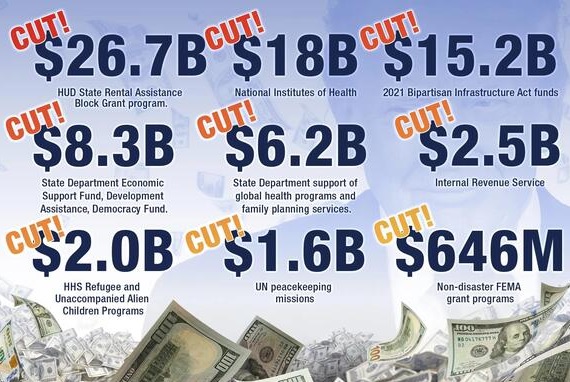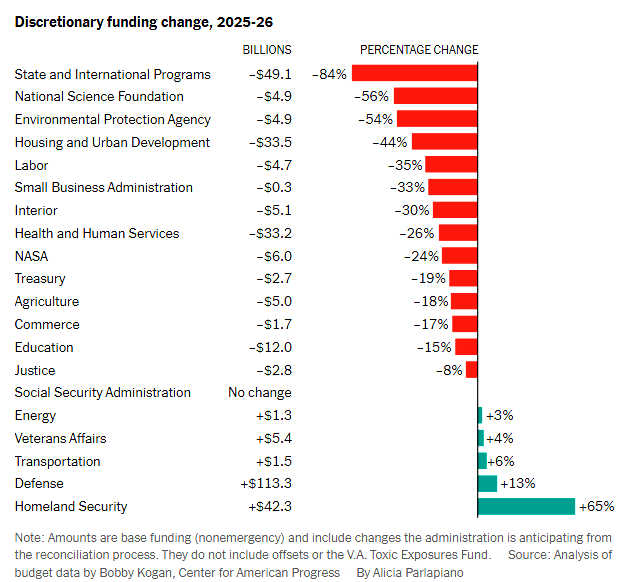
Economic indicators released this week revealed the US economy is slowing down in the first quarter of 2025, but President Donald Trump and his administration are expressing confidence in his agenda, CNN reports.
Most economists say Trump’s monumental bid to reshape global trade is likely to send inflation climbing in the US — and could even trigger a recession.
Here is what some of the numbers are saying:
Manufacturing output: The US manufacturing industry contracted in April at a faster clip, with production seeing its fastest contraction since 2020, according to a survey released by the Institute for Supply Management. The group’s Manufacturing Purchasing Managers Index registered a reading of 48.7 in April, down slightly from March’s 49, and the lowest level since November. A reading above 50 equals expansion, while anything below that threshold indicates a contraction.
Gross domestic product: The country’s GDP registered at an annualized rate of -0.3% in the first quarter, the Commerce Department said. That’s a sharp slowdown from the fourth quarter’s 2.4% rate, and much worse than the 0.8% rate economists projected. GDP is adjusted for seasonal swings and inflation. US stocks dropped after the GDP report was released.
Consumer spending: This metric, which powers about 70% of the US economy, slowed sharply in the first quarter to a 1.8% rate, down considerably from 4% in the prior three-month period. That slowdown was largely due to Americans cutting their spending on goods, and was the weakest rate since mid-2023. Government spending also weighed on the economy, with federal outlays dropping to -5.1% from 4% during the same period.
 Trump’s plan will slash billions from woke, corrupt programs.
Trump’s plan will slash billions from woke, corrupt programs.
Pic.: The NY Post
The president’s $1.7 trillion discretionary budget blueprint would cut $163 billion for the 2026 fiscal year, offering an outline of his vision for Washington and dramatically curtailing the role and reach of the federal government, writes ‘The New York Times’.
President Trump proposed slashing $163 billion in federal spending next fiscal year.
Issuing his first budget proposal since returning to office, Mr. Trump sketched out a dim view of Washington. His blueprint depicted many core government functions as woke, weaponized, wasteful or radical, as the president looked to justify his request that Congress chop domestic spending to its lowest level in the modern era.
President Trump’s budget proposes shrinking nondefense funding to its lowest level since the 1960s, when these records began.
Mr. Trump proposed cutting funding for some federal law enforcement, including the F.B.I. He called on lawmakers to slash money meant to police tax evasion at the Internal Revenue Service. He recommended striking billions in funds that help finance clean water projects. And the president reserved some of his deepest cuts for education, health and science, including the National Institutes of Health and the Centers for Disease Control and Prevention, which would see their budgets cut by around half.
Democrats immediately rebuked Mr. Trump for his proposal. Senator Chuck Schumer of New York, the Senate minority leader, called it “heartless” and an “all-out assault on hardworking Americans.” Even some Republicans took issue with Mr. Trump’s budget, although others, like Speaker Mike Johnson, endorsed the blueprint.
In one of the few spending increases included in the budget, Mr. Trump asked lawmakers to bolster spending at the Department of Homeland Security by more than $43 billion, furthering his work to crack down on immigration, conduct deportations and build a wall along the U.S.-Mexican border. The president also requested more than $1 trillion for the military next fiscal year.
For Mr. Trump, the budget served to formalize his conservative vision and his reorganization of the government, a campaign that has already shuttered entire agencies and dismissed thousands of federal workers without the explicit approval of Congress.
Mr. Trump’s budget supported the creation of a new missile defense shield and a renewed campaign for “U.S. space dominance.”
The budget proposes redistributing the $163 billion in cuts to a handful of agencies, including defense and homeland security.

In a letter accompanying the spending blueprint, Russell T. Vought, the leader of the White House budget office, said the administration had produced its submission after a “rigorous, line-by-line review of spending.”
Mr. Vought added that the president sought to root out money “contrary to the needs of ordinary working Americans and tilted toward funding niche, nongovernmental organizations and institutions of higher education committed to radical gender and climate ideologies antithetical to the American way of life.”
Mr. Trump’s proposal is not law. Totaling about $1.7 trillion, after accounting for the full set of spending changes the president seeks, the budget serves only as a formal guide to Congress, where it immediately generated opposition.
The criticism was not limited to Democrats, as Republicans also raised alarm about cuts to some programs that serve the neediest Americans. Outlining her “serious objections,” Senator Susan Collins, a Maine Republican who leads the Appropriations Committee, added in a statement: “Ultimately, it is Congress that holds the power of the purse.”
By releasing the budget, Mr. Trump set the stage for what is bound to be a complicated, monthslong process to fund the government and avert a shutdown before an existing spending deal expires on Sept. 30. Entering that fight, many Republicans have echoed Mr. Trump’s desire to slash federal spending.
But Mr. Trump’s proposal carries additional significance. He and his top budget adviser, Mr. Vought, subscribe to the idea that the commander in chief wields expansive authority to halt or cancel spending, even if Congress instructs otherwise. Their view has paved the way for the administration to slow, freeze or cancel billions of dollars in funds, sparking a vast array of lawsuits and prompting more than three dozen ongoing federal investigations into their activities.
The president’s new budget does not address the future of the federal benefit programs, including Social Security, Medicare and Medicaid, that comprise the largest share of federal spending annually. Some Republicans are particularly interested in rethinking Medicaid, which provides health insurance to poor families, as a source of savings to pay for their tax cuts.
The administration is expected to send those details in a fuller budget to Congress as soon as this month.
read more in our Telegram-channel https://t.me/The_International_Affairs

 10:46 04.05.2025 •
10:46 04.05.2025 •






















